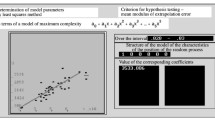This is a statistical analysis of data on type SN Ia supernovae from which it was concluded during 1998–1999 that the expansion of the universe is accelerating. The hypothesis that there exists a standard value of the red shift in the spectra of type SN Ia supernovae that corresponds to a standard value of the absolute stellar magnitude for distance determinations is examined.


Similar content being viewed by others
Notes
The χ2 statistic is actually the likelihood function of a mixture of gaussian distributions. This violates the condition of statistical uniformity of the data with respect to their dispersions (the homoscedacity condition).
The abbreviations for the names of these methods contain the letters MMK from the maximum compactness method (from the name of the basic method of Ref. 12).
References
K. Lang, Astrophysical Formulae [Russian translation], Mir, Moscow (1978), Part 2.
Encyclopedia of Physics, Bolshaya Rossiiskaya Entsiklopediya, Moscow (1994), Vol. 4.
A. G. Riess et al., “Observational evidence from supernovae for an accelerating universe and a cosmological constant,” Astronom. J., 116, 1009–1038 (1998).
S. Perlmutter et al., “Measurements of Ω and Λ from 42 high-red shift supernovae,” Astrophys. J., 517, 565–586 (1999).
M. V. Sazhin, “Anisotropy and polarization of the cosmic background radiation. State of the art,” Usp. Fiz. Nauk, 174, No. 2, 197–205 (2004).
G. Hinshaw et al., “9-year Wilkinson microwave anisotropy probe observations: Cosmological parameter results,” http://wmap_9yr_cosmology_results, accessed Dec. 31, 2012.
“Planck 2013 results. I. Overview of products and scientific results,” Astron. Astrophys., http://arXiv:1303.5062v1[astro-ph.CO], accessed May 28, 2013.
S. M. Carroll, W. H. Press, and E. L. Turner, “The cosmological constant,” Ann. Rev. Astron. Astrophys., 30, 499–542 (1992).
D. J. Schwarz and B. Weinhorst, “(An)isotropy of the Hubble diagram: comparing hemispheres,” Astron. Astrophys., 474, 717–729 (2007).
J. Sollerman et al., “First-year Sloan digital sky Survey-II supernova results: constraints on non-standard cosmological models,” http://arXiv:0908.4276v2[astro-ph.CO], accessed Sep. 1, 2009.
S. F. Levin, “Measurement problems in the statistical identification of the scale of cosmological distances,” Izmer. Tekhn., No. 12, 7–22 (2011); Measur. Techn., 54, No. 12, 1334–1341 (2011).
R 50.2.004-2000, GSI. Determination of the Characteristics of Mathematical Models for the Relationships Between Physical Quantities in Solving Measurement Problems. Basic Assumptions.
MI 2091–90, GSI. Measurement of Physical Quantities. General Specifications.
MI 2916–2005, GSI. Identification of the Distributions of Probabilities in Solving Measurement Problems.
A. N. Shiryaev, Statistical Sequential Analysis, Nauka, Moscow (1976).
S. F. Levin, “Identification of interpretive models in the theory of gravitation and cosmology,” Physical Interpretations of Relativity Theory PIRT-2003: Proc. Int. Sci. Meeting, BMSTU, Moscow (2003), pp. 72–81.
P. E. El’yasberg, Measurement Data: How Much is Needed? How Should it be Processed, Nauka, Moscow (1983).
F. Hempel et al., Robust Statistics. The Approach Based on Influence Functions [Russian translation], Mir, Moscow (1989).
S. F. Levin, “Cosmological distance scale: paradoxes in red shift models,” Izmer. Tekhn., No. 3, 3–6 (2013); Measur. Techn., 56, No. 3, 217–222 (2013).
S. F. Levin, “Cosmological distance scale based on a red-shift interpolation model,” Izmer. Tekhn., No. 6, 12–14 (2012); Measur. Techn., 55, No. 6, 609–612 (2012).
S. F. Levin, “Photometric scale of cosmological distances: Anisotropy and nonlinearity, isotropy and zero-point,” Physical Interpretation of Relativity Theory PIRT-2013: Proc. Int. Sci. Meeting, BMSTU, Moscow (2013), pp. 210–219.
Author information
Authors and Affiliations
Corresponding author
Additional information
Translated from Izmeritel’naya Tekhnika, No. 9, pp. 8–12, September, 2014.
Rights and permissions
About this article
Cite this article
Levin, S.F. Cosmological Distance Scale. Part 3. Red Shift Standards. Meas Tech 57, 960–966 (2014). https://doi.org/10.1007/s11018-014-0566-1
Received:
Published:
Issue Date:
DOI: https://doi.org/10.1007/s11018-014-0566-1




